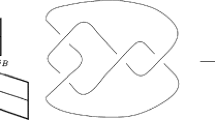Abstract
We study the secondary structure of RNA determined by Watson–Crick pairing without pseudo-knots using Milnor invariants of links. We focus on the first non-trivial invariant, which we call the Heisenberg invariant. The Heisenberg invariant, which is an integer, can be interpreted in terms of the Heisenberg group as well as in terms of lattice paths. We show that the Heisenberg invariant gives a lower bound on the number of unpaired bases in an RNA secondary structure. We also show that the Heisenberg invariant can predict allosteric structures for RNA. Namely, if the Heisenberg invariant is large, then there are widely separated local maxima (i.e., allosteric structures) for the number of Watson–Crick pairs found.
Similar content being viewed by others
References
Cochran TD, Orr KE (1993) Not all links are concordant to boundary links. Ann Math (2) 138(3): 519–554
Cochran TD, Orr KE (2003) Teichner, Peter Knot concordance, Whitney towers and L 2-signatures. Ann Math (2) 157(2): 433–519
Casson AJ (1975) Link cobordism and Milnor’s invariant. Bull London Math Soc 7: 39–40
Freedman MH (1995) Teichner, Peter 4-manifold topology. I. Subexponential groups. Invent Math 122(3): 509–529
Giffen CH (1979) Link concordance implies link homotopy. Math Scand 45(2): 243–254
Goldsmith DL (1979) Concordance implies homotopy for classical links in M 3. Comment Math Helv 54(3): 347–355
Krushkal VS (1998) Additivity properties of Milnor’s \({\overlineµ}\) -invariants. J Knot Theory Ramifications 7(5): 625–637
Levine JP (1987) Surgery on links and the \({\overlineµ}\) -invariants. Topology 26(1): 45–61
Milnor J (1954) Link groups. Ann Math 59(2): 177–195
Milnor J (1957) Isotopy of links. Algebraic geometry and topology. A symposium in honor of S. Lefschetz. Princeton University Press, Princeton, NJ, pp 280–306
Stallings J (1965) Homology and central series of groups. J Algebra 2: 170–181
Gesteland RF, Atkins JF (1993) The RNA world: the nature of modern RNA suggests a prebiotic RNA world. Cold Spring Harbor Laboratory Press, NY, USA
Fox GE, Woese CR (1975) RNA secondary structure. Nature 256: 505
Gardner PP, Giegerich RA (2004) Comprehensive comparison of comparative RNA structure prediction approaches. BMC Bioinform 5: Art. No. 140
Ding Y (2003) A statistical sampling algorithm for RNA secondary structure prediction. Nucleic Acids Res 31: 7280
Dirks RM (2003) A partition function algorithm for nucleic acid secondary structure including pseudoknots. J Comput Chem 24: 1664
Fields DS (1996) An analysis of large rRNA sequences folded by a thermodynamic method. Fold Des 1: 419
Gorodkin J (2001) Discovering common stem-loop motifs in unaligned RNA sequences. Nucleic Acids Res 29: 2135
Higgs PG (2000) RNA secondary structure: physical and computational aspects. Quart Rev Biophys 33: 199
Hofacker IL (2004) Alignment of RNA base pairing probability matrices. Bioinformatics 20: 2222
Jeffares DC (1998) Relics from the RNA world. J Mol Evol 46: 18
Ji YM (2004) A graph theoretical approach for predicting common RNA secondary structure motifs including pseudoknots in unaligned sequences. Bioinformatics 20: 1591
Knudsen B (1999) RNA secondary structure prediction using stochastic context-free grammars and evolutionary history. Bioinformatics 15: 446
Moulton V (2000) Metrics on RNA secondary structures. J Comput Biol 7: 277
Nussinov R (1978) Algorithms for loop matchings. SIAM J Appl Math 35: 68
Rivas E (2000) The language of RNA: a formal grammar that includes pseudoknots. Bioinformatics 16: 334
Tinoco I (1999) How RNA folds. J Mol Biol 293: 271
Wang ZZ (2001) Alignment between two RNA structures. Math Found Comput Sci 2136: 690
Author information
Authors and Affiliations
Corresponding author
Additional information
Partially supported by DST (under grant DSTO773) and UGC (under SAP-DSA Phase IV).
Rights and permissions
About this article
Cite this article
Gadgil, S. Watson–Crick pairing, the Heisenberg group and Milnor invariants. J. Math. Biol. 59, 123–142 (2009). https://doi.org/10.1007/s00285-008-0223-x
Received:
Revised:
Published:
Issue Date:
DOI: https://doi.org/10.1007/s00285-008-0223-x




